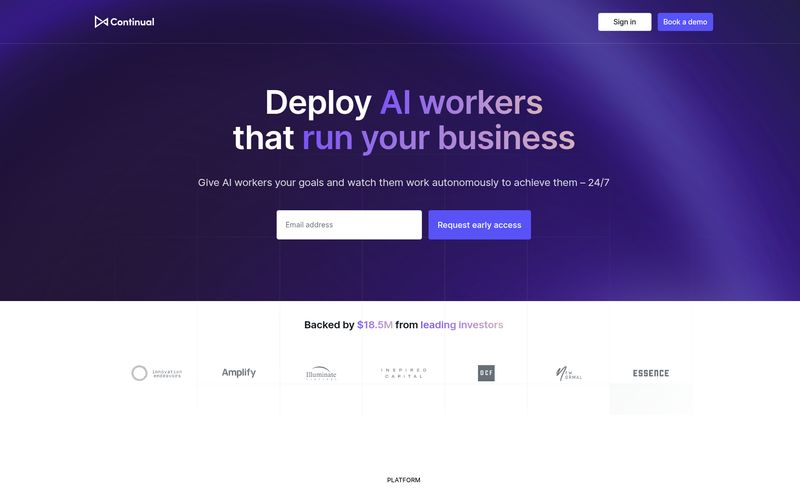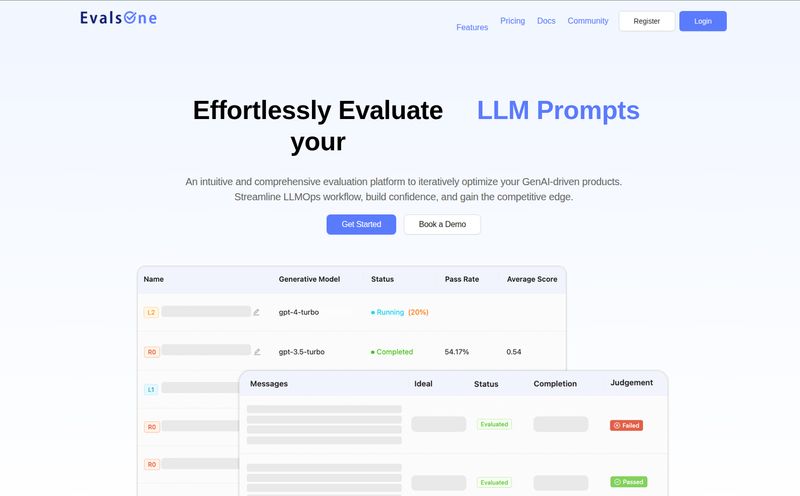The world of software development is getting… crowded. Not with people, but with tools. Specifically, AI tools. Every week there’s a new “revolutionary” AI assistant that promises to write all your code, fix all your bugs, and probably make you a perfect cup of coffee. Most of them are pretty good, but they often feel like a one-size-fits-all solution. A bit rigid. Like trying to do serious woodworking with a plastic toy hammer.
I’ve been in this SEO and traffic game for years, which means I've spent more time than I'd like to admit staring at code, scripts, and API integrations. So when I see a tool that doesn’t just want to be my assistant, but wants me to build my own assistant, my ears perk up. That’s the promise of Continue, and I have to say, I'm intrigued.
So, What Exactly is Continue?
Forget the buzzwords for a second. At its heart, Continue is an open-source extension for your IDE (it plays nice with both VS Code and JetBrains) that acts as your coding copilot. Think of it as a framework for building your perfect AI helper, right inside the environment where you do your actual work. It’s not just another ChatGPT wrapper. It’s a customizable engine. It’s less like renting a pre-furnished apartment and more like being handed the keys to a fully-stocked workshop. You get to decide which tools to use and how to arrange them.
The big idea is that you can plug in any AI model you want—from the big players like OpenAI’s GPT-4 and Anthropic’s Claude to your own locally-run models via something like Ollama. You also tell it what context to use, which is a massive deal. This means it can genuinely understand your entire project, not just the single file you have open.

Visit Continue
The Core Features That Actually Matter
Marketing pages are full of fluff. Let’s break down the features I actually found useful during my testing.
Smarter Autocomplete Than Your Average Bear
We've all gotten used to autocomplete. It's fine. But Continue's version feels different. Hitting 'Tab' doesn’t just complete the line; it often suggests entire blocks of logical, context-aware code. Because it can be fed context from your other files, the suggestions are startlingly relevant. It feels less like a guess and more like a suggestion from a pair programmer who has actually been paying attention.
Chatting With Your Codebase is a Game Changer
This is where things get really cool. You can highlight a chunk of code, a file, or even just type '@' to pull in different parts of your project as context for a chat. Ever tried to refactor a complex function that touches three other services? Instead of juggling a dozen browser tabs and trying to explain the architecture to a generic chatbot, you can just ask Continue: “@main.py @utils.js Hey, how can I refactor this Python function to do X without breaking the JavaScript that calls it?” The quality of the answer you get back is on another level because the AI has the full picture. It’s a massive time saver and, honestly, a sanity saver.
Editing Code With Plain English
The 'highlight and edit' function feels like a bit of magic. You can select a piece of code and just… tell it what to do. Highlight a clunky for-loop and type “convert this to a more efficient list comprehension.” And poof, it does it. Or select an entire function and say “add JSDoc comments and error handling.” It’s not perfect every single time, but its a ridiculously fast way to handle boilerplate tasks and refactoring. It just cuts out so much of the tedious typing.
The Real Power: Open-Source and Total Customization
Here’s the part that separates Continue from the pack. Most AI tools are a black box. You use the model they give you, you trust their privacy policy (or try to), and you work within their limits. Continue throws that model out the window.
Want to use the brand-new model from Google? Plug it in. Worried about sending your proprietary code to a third-party server? Run a powerful open-source model like Llama 3 locally on your own machine. Continue acts as the bridge. This level of control is something power users and enterprise teams have been dreaming of. You're not locked into one ecosystem. You have freedom. It means your company can set up a standardized, secure, and completely custom AI assistant for all its developers, using models that are approved and safe.
My Honest Take: The Good, The Bad, and The Code
Okay, it's not all sunshine and perfectly generated code. While I’m pretty high on this tool, it's important to be real about the downsides. The biggest “con” is also its biggest “pro”: customization. If you’re a developer who just wants to install something and have it work instantly with zero configuration, GitHub Copilot might still be your best bet. Continue does require some initial setup. You have to connect your models, and you might need to tweak the configuration to get it just right.
There's a bit of a learning curve, especially if you want to get into advanced configurations like setting up custom context providers. Also, the tool is only as good as the AI model you plug into it. If you hook it up to a weak or poorly-configured model, you’re going to get weak results. Garbage in, garbage out, as they say.
But for me? The little bit of upfront effort is a small price to pay for the incredible power and flexibility you get in return. The ability to fine-tune my own coding assistant is something I never knew I needed, and now I'm not sure I can go back.
So, What's the Price of Freedom?
This is often the first question people ask. And the answer is… it’s free. As an open-source project, the core Continue extension is free to download and use. Of course, you’ll have to pay for API access if you choose to connect to a paid model like GPT-4, but that’s between you and the model provider. If you use a local open-source model, the entire setup can be completely free of charge. I imagine they might offer enterprise support or a hosted cloud version down the line, but for the individual dev, you can get started without opening your wallet.
Is Continue Right For You?
After spending a good amount of time with it, here’s my final thought. If you’re a developer who loves to tinker, who values control over their tools, and who wants to build a coding environment perfectly suited to their workflow, then you need to stop what you're doing and download Continue right now. Seriously.
If you're newer to development or prefer tools that are plug-and-play, it might feel like a bit much. But even then, I'd encourage you to give it a try. The default setup is still incredibly powerful. This feels like the future of developer tools—not just tools that help us, but tools that we can shape and mold into true partners in our work.
Frequently Asked Questions
- Is Continue really free to use?
- Yes, the Continue extension itself is open-source and free. You will only incur costs if you connect it to a paid AI model API, like those from OpenAI or Anthropic. Using it with a free or locally-hosted model is completely free.
- What IDEs does Continue support?
- Currently, Continue has official support and extensions for Visual Studio Code (VS Code) and the full suite of JetBrains IDEs (like PyCharm, WebStorm, and IntelliJ IDEA).
- Can I use my own AI models with Continue?
- Absolutely. This is one of its main features. You can connect to major providers, or you can run your own models locally using tools like Ollama, LM Studio, or others, giving you full control and privacy.
- How is Continue different from GitHub Copilot?
- The primary difference is customization and control. GitHub Copilot is a closed-source product with a specific set of models. Continue is an open-source framework that lets you choose your AI model, your context sources, and fine-tune its behavior to create a personalized assistant.
- Is it difficult to set up?
- There is a slightly steeper learning curve than a simple plug-and-play tool. You'll need to configure which AI model you want to use, which might involve adding an API key. However, the documentation is clear, and for power users, this setup process is part of the appeal.
- Does Continue work offline?
- Yes, it can! If you configure Continue to use an AI model that is running locally on your machine (for example, through Ollama), your entire workflow can be 100% offline and private.
Reference and Sources
- Continue Official Website
- Continue on VS Code Marketplace
- Continue on JetBrains Marketplace
- Ollama - For running local LLMs



